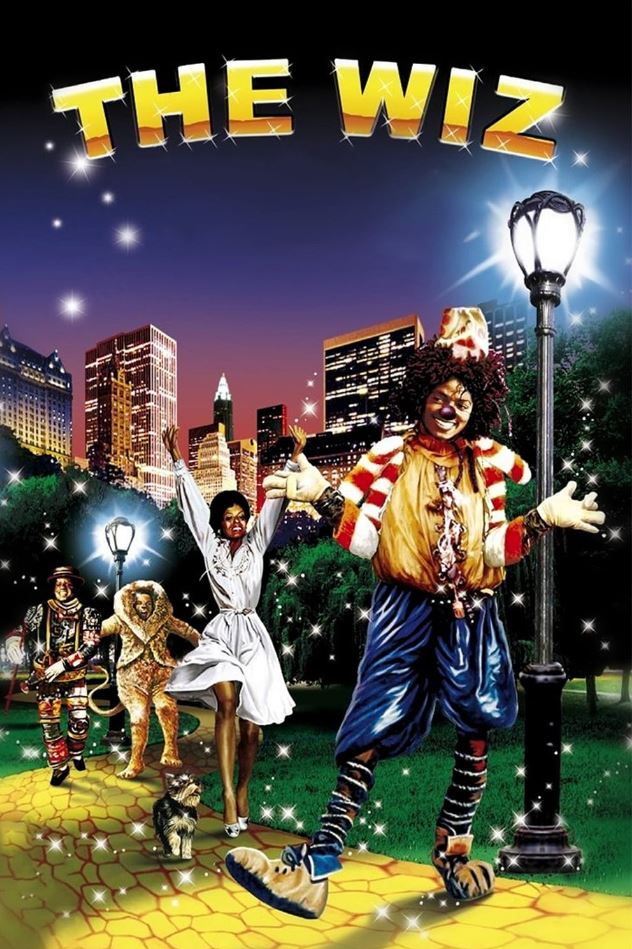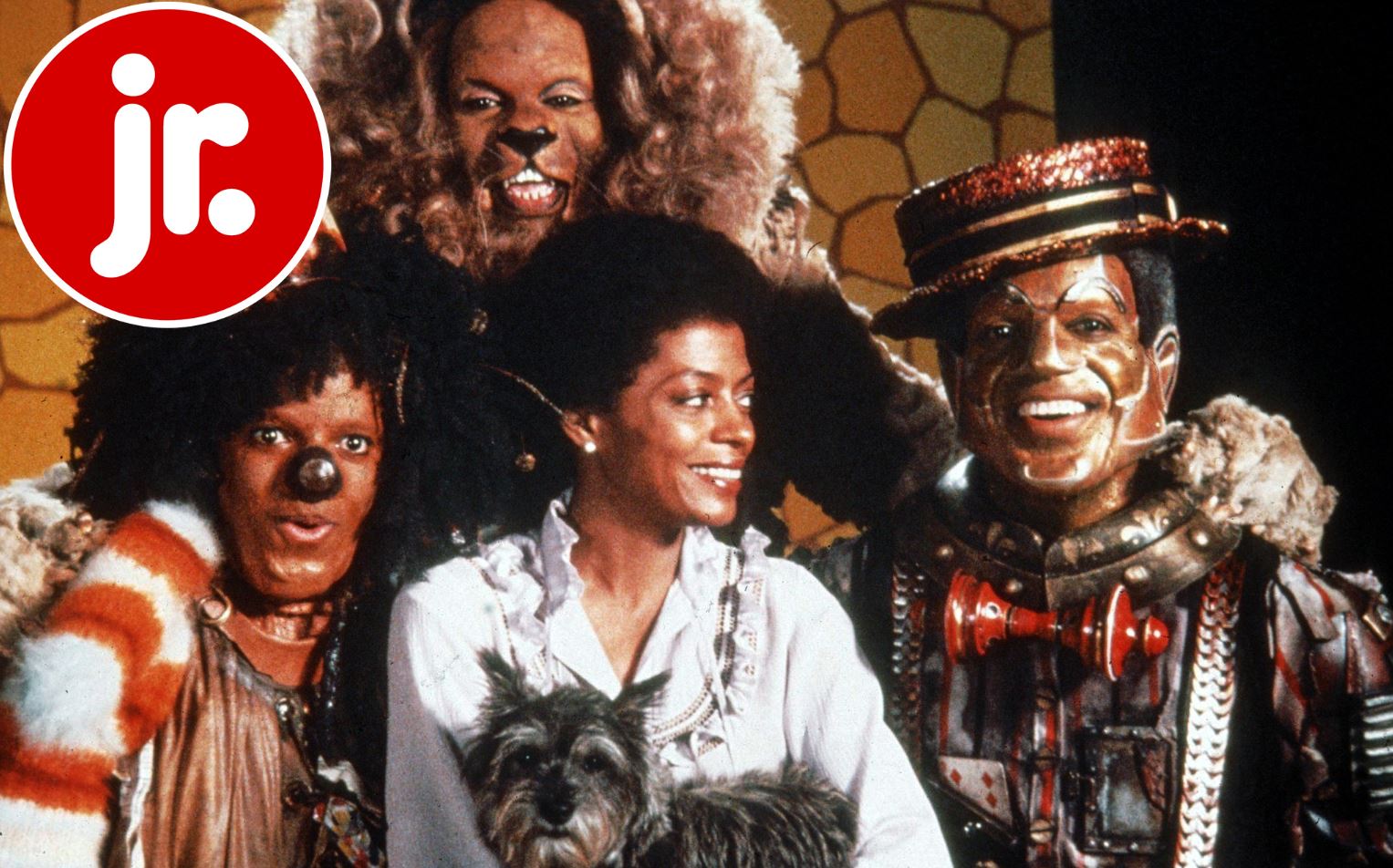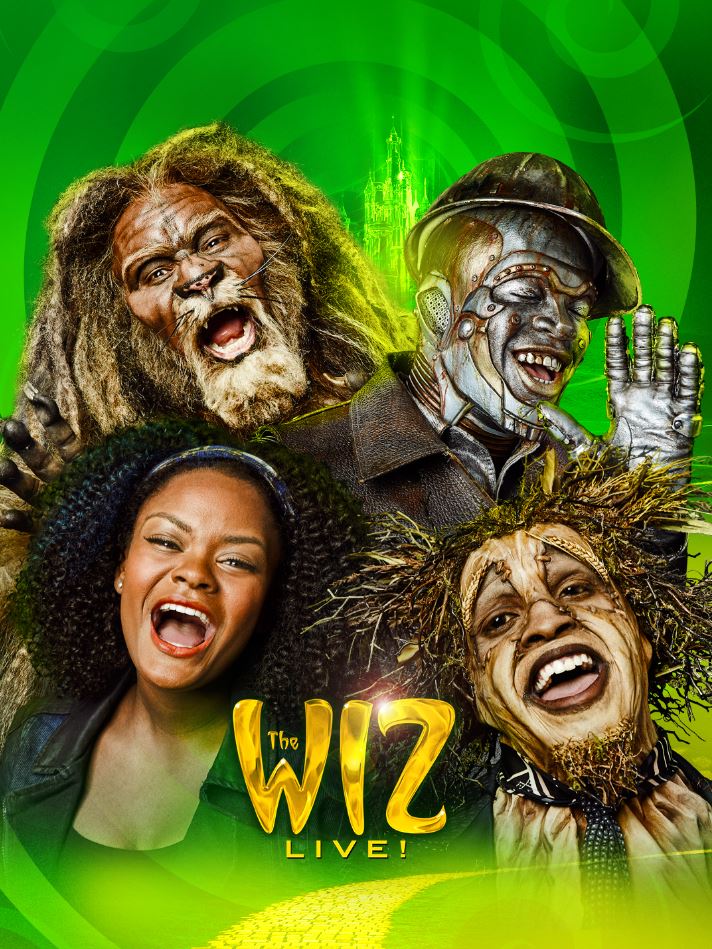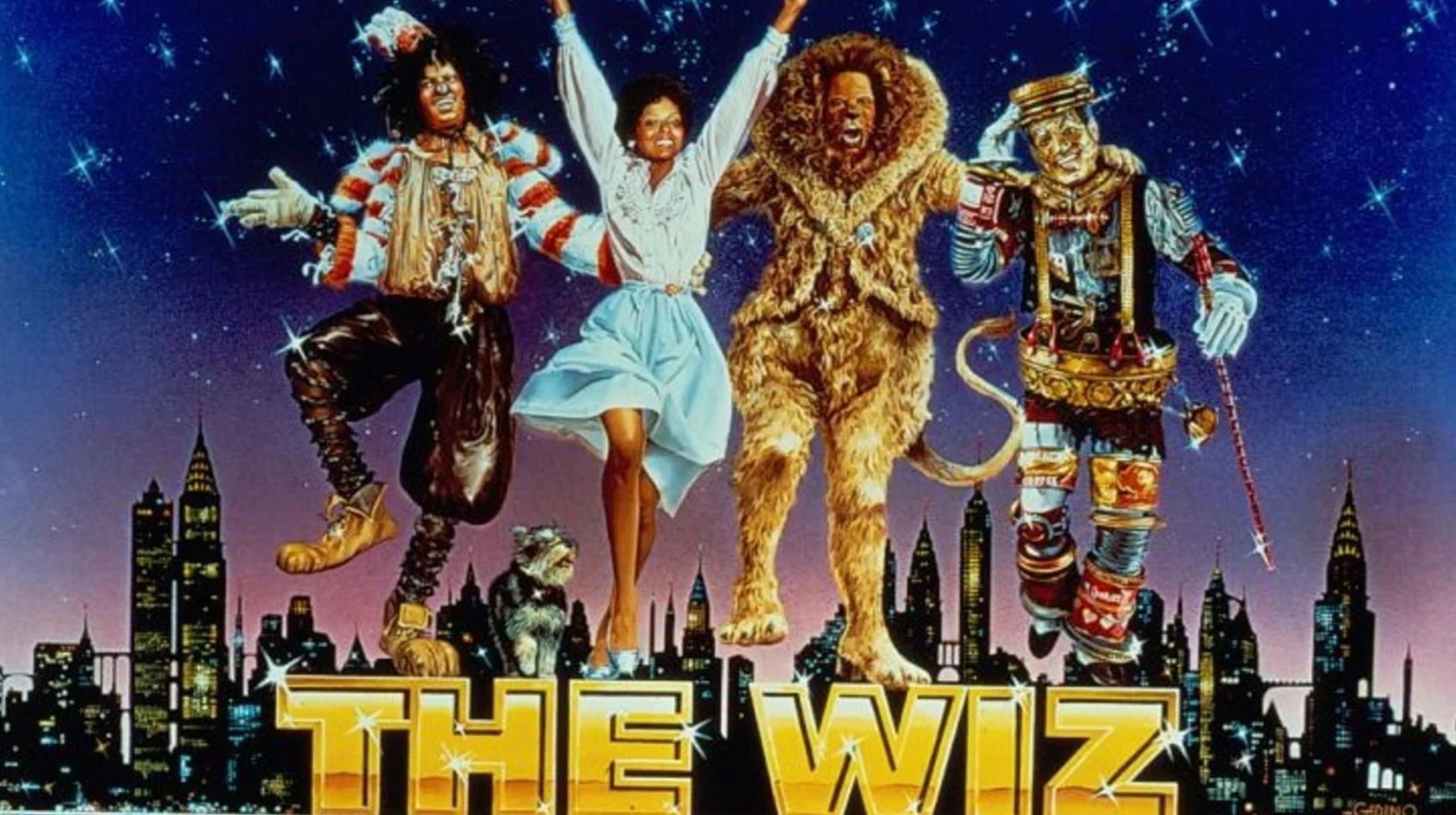The Wiz (film), released in 1978, stands as a remarkable adaptation of the Broadway musical bearing the same name, which itself was a creative reinterpretation of L. Frank Baum’s beloved 1900 children’s novel, “The Wonderful Wizard of Oz.” Directed by Sidney Lumet and produced by Universal Pictures alongside Motown Productions, this film reimagined the classic Oz narrative through the lens of African-American culture, bringing a vibrant and distinct flair to the timeless story.
Set against the urban backdrop of a fantastical New York City, “The Wiz” features Dorothy, a shy schoolteacher from Harlem, who embarks on a magical journey through the Land of Oz. This journey is accentuated by a cast comprising entirely African-American actors, including Diana Ross as Dorothy, Michael Jackson in his film debut as the Scarecrow, and Richard Pryor as the titular Wiz. This casting choice was not just a nod to diversity but a bold statement in the post-civil rights era, aiming to resonate with wider audiences and provide a fresh perspective on a well-trodden tale.
Despite its innovative approach and star-studded lineup, “The Wiz” faced a rocky start, greeted by both commercial failure and critical indifference upon its initial release. The film’s attempts to blend fantasy with the contemporary urban experience, while ambitious, did not translate well at the box office, and it garnered generally negative reviews, with critics often comparing it unfavorably to the original book and its 1939 Hollywood adaptation.
However, as years passed, “The Wiz” transcended its initial reception, growing in appreciation among new generations and niche audiences. It emerged as a cult classic, cherished for its unique reinterpretation of Oz and its role in showcasing African-American talents in major cinematic roles. The film’s journey from a perceived flop to a beloved classic underscores the changing dynamics of film reception and the lasting appeal of seeing familiar stories through a new cultural lens.
| Aspect | Details |
|---|---|
| Release Year | 1978 |
| Based On | Broadway musical “The Wiz”; L. Frank Baum’s “The Wonderful Wizard of Oz” |
| Director | Sidney Lumet |
| Production | Universal Pictures, Motown Productions |
| Setting | Fantastical New York City |
| Main Cast | Diana Ross as Dorothy, Michael Jackson as the Scarecrow, Richard Pryor as the Wiz |
| Initial Reception | Commercial failure, critical indifference |
| Legacy | Grew into a cult classic, appreciated for its cultural reinterpretation and showcasing African-American talents |
Contents
The Genesis of “The Wiz”
The journey of “The Wiz” from Broadway to the silver screen encapsulates a fascinating transition, underpinned by the strategic collaborations between Motown Productions and Universal Pictures. Originally a hit on Broadway in 1974, the musical’s adaptation into a film was driven by the visionary efforts of producer Rob Cohen and music mogul Berry Gordy. The transition was not just a change in medium but a reimagining of a classic American story through a contemporary and culturally specific lens, aiming to resonate with African-American audiences.
One of the most pivotal moments in the pre-production phase was the casting of Diana Ross as Dorothy. Despite being significantly older than the traditional Dorothy character, Ross was passionate about playing this role. At 33, Ross was seen by many, including Motown’s Berry Gordy, as too mature for the part of the innocent and youthful Dorothy. However, her determination led to a direct appeal to Universal Pictures, bypassing Gordy, and ultimately securing her role through her sheer persistence and star power. This casting decision marked a significant shift in the project’s direction and set the stage for further unconventional casting choices.

Diana Ross’s casting as Dorothy was just the beginning of a series of intriguing casting decisions. Michael Jackson, then a young star transitioning from his early career with the Jackson 5, was cast as the Scarecrow. This role allowed Jackson to showcase his acting abilities in his feature film debut, bringing a fresh vulnerability and charisma to the character. His performance remains one of the most celebrated aspects of the film.
Other notable cast members included Nipsey Russell as the Tin Man, Ted Ross as the Cowardly Lion, and Richard Pryor as the enigmatic Wiz. Each actor brought their own unique flair to the film, transforming their Broadway counterparts into vivid screen personas. The casting of Ted Ross, who reprised his role from the Broadway production, and the decision to cast Pryor, a comedian with no previous musical film experience, as the Wiz highlighted the film’s blend of drama, music, and comedy, tailored to a broader audience.
Michael Jackson’s casting as the Scarecrow was particularly notable. Initially, the role was envisioned for someone with a comedic background, but Jackson’s embodiment of the character added a layer of depth and tenderness that became a highlight of the film. This decision underscored the film’s commitment to showcasing emerging African-American talent in a new light.
| Aspect | Details |
|---|---|
| Transition | From Broadway (1974) to film (1978), produced by Rob Cohen and Berry Gordy |
| Collaborations | Strategic partnership between Motown Productions and Universal Pictures |
| Casting of Diana Ross | Ross, at age 33, bypassed Berry Gordy to appeal directly to Universal, securing the role of Dorothy |
| Notable Cast Members | Michael Jackson as Scarecrow, Nipsey Russell as Tin Man, Ted Ross as Cowardly Lion, Richard Pryor as the Wiz |
| Michael Jackson’s Role | Transitioned from music to acting, brought depth and vulnerability to the Scarecrow, enhancing the film’s appeal |
| Impact of Casting Choices | Unconventional casting choices like Diana Ross and Richard Pryor set a distinct direction, blending drama, music, and comedy |
Filming and Production Challenges
The production of “The Wiz” was predominantly based in New York City, utilizing both the urban backdrop and the iconic landmarks of Queens. Filming locations included the Astoria Studios and the decaying structures of the New York State Pavilion, originally constructed for the 1964 New York World’s Fair. These locations were chosen to mirror the fantastical yet familiar landscape of Oz, reimagined as a dream-like version of New York City.
The set design was a crucial element of the film, blending the familiar with the surreal. The New York State Pavilion was transformed into the whimsical and colorful Munchkinland, while other real-world locations, like the World Trade Center, doubled as parts of the Emerald City. These settings provided a stark contrast to the original Oz, depicting a more modern and urban environment that aligned with the film’s contemporary reinterpretation.

Tony Walton, the costume designer, played a vital role in bringing the magical world of Oz to life. Walton collaborated with high-fashion designers and utilized an array of exotic fabrics and designs to create the film’s vibrant and elaborate costumes. The Emerald City sequence, in particular, showcased a spectacular array of costumes, drawing from avant-garde fashion to reflect the futuristic and otherworldly ethos of the city.
The production also faced significant challenges, particularly in terms of budget and logistics. The ambition of the film’s visual and special effects, coupled with its extensive use of elaborate sets and costumes, led to budget overruns and production delays. Despite these challenges, the film’s visual spectacle was a testament to the creativity and resilience of its production team, ultimately setting a new standard for the visual presentation of musicals in cinema.
| Aspect | Details |
|---|---|
| Main Location | New York City, specifically Queens |
| Filming Locations | Astoria Studios, New York State Pavilion (1964 World’s Fair site) |
| Set Design | Transformed real-world NYC locations into fantastical Oz settings, like Munchkinland and Emerald City |
| Costume Design | Tony Walton; collaborated with high-fashion designers, used exotic fabrics for vibrant and elaborate costumes |
| Production Challenges | Significant budget overruns and production delays due to the ambition of visual and special effects |
| Impact on Cinema | Set a new standard for the visual presentation of musicals |
Musical Score and Performances
Quincy Jones, a legend in music production, played an integral role as the musical supervisor for “The Wiz.” His collaboration with songwriters Charlie Smalls and Luther Vandross was pivotal in transforming the stage musical into a cinematic score that resonated with both new and familiar audiences. Jones’ expertise not only in jazz and pop but also in film scores enriched the musical landscape of “The Wiz,” integrating a soulful depth to the film’s auditory experience.
Jones supervised the adaptation and modification of songs from the Broadway show and oversaw the creation of new compositions that would better suit the film’s broader and more diverse audience. His ability to blend different musical styles helped create a soundtrack that was both timeless and reflective of African-American musical traditions, which played a crucial role in setting the tone and pace of the film.

Among the standout tracks in “The Wiz,” “Ease on Down the Road” became an anthem of resilience and friendship, mirroring Dorothy and her companions’ journey through the fantastical landscapes of Oz. This song, performed by Diana Ross and Michael Jackson, highlighted their dynamic chemistry and became a memorable musical moment that epitomized the film’s spirit.
Another significant track, “A Brand New Day,” celebrated the liberation from the Wicked Witch of the West. This song, with its powerful chorus and uplifting melody, became a symbol of freedom and new beginnings, resonating deeply with audiences and remaining one of the film’s most powerful and enduring songs. These musical numbers not only advanced the storyline but also showcased the film’s unique ability to transform a traditional narrative into a celebratory expression of African-American culture.
| Role | Details |
|---|---|
| Title | Musical Supervisor |
| Collaborations | Worked with Charlie Smalls and Luther Vandross |
| Contributions | Adapted Broadway songs, supervised new compositions to suit a broader audience |
| Music Style | Blended various musical styles, enriching the film with soulful depth and reflecting African-American traditions |
| Notable Songs | “Ease on Down the Road” by Diana Ross and Michael Jackson, “A Brand New Day” |
| Impact | Helped set the film’s tone and pace, transforming traditional narratives into expressions of African-American culture |
Critical Reception and Legacy
Upon its release, “The Wiz” encountered a less than enthusiastic reception at the box office, grossing significantly less than its production costs, and received generally unfavorable reviews from critics. Many reviewers criticized the film for its departure from the traditional “Wizard of Oz” tale and for its perceived over-stylization and lack of coherent narrative flow. Diana Ross’s portrayal of Dorothy drew particular scrutiny, with many feeling that her age was not suitable for the youthful character traditionally depicted in the story.
Despite its initial setbacks, “The Wiz” underwent a dramatic reevaluation over the years. As audiences began to appreciate the film’s deeper cultural messages and its celebration of African-American identity, it gradually garnered a status as a cult classic. The film’s innovative use of music, costume, and set design has been reassessed as ahead of its time, providing a rich, textured backdrop that brought a new dimension to the Oz narrative.

The reinterpretation of the classic Oz story through an urban and African-American lens has been increasingly recognized for its creativity and significance. This shift in perception reflects broader changes in societal attitudes towards race and representation in cinema, acknowledging “The Wiz” as a pioneering work in the context of African-American film.
“The Wiz” has also left an indelible mark on subsequent adaptations and productions. Notably, “The Wiz Live!”—a live television adaptation aired in 2015—drew direct inspiration from the film, capturing its essence while updating it for a new generation. This production, along with others, underscores “The Wiz”‘s lasting impact on the portrayal of African-American culture in mainstream media and its role in inspiring future artistic endeavors that seek to blend cultural specificity with universal themes.
In summary, “The Wiz” stands as a testament to the enduring power of reimagined stories when infused with new cultural perspectives and artistic vision. From its music to its performances and its complex legacy, the film continues to inspire and resonate, transcending its original critiques to secure a beloved place in American cinema history.
| Aspect | Details |
|---|---|
| Initial Reception | Commercial failure, criticized for departure from traditional “Wizard of Oz” and over-stylization |
| Criticism Focus | Diana Ross’s portrayal of Dorothy, deemed unsuitable due to her age |
| Reevaluation | Grew into a cult classic; recognized for its cultural messages and innovative use of music, costume, and set design |
| Cultural Significance | Appreciated for its reinterpretation of the Oz narrative through an urban and African-American lens |
| Legacy and Influence | Inspired adaptations like “The Wiz Live!” (2015); acknowledged for its impact on African-American representation in media |
| Enduring Impact | Continues to inspire artistic endeavors blending cultural specificity with universal themes |
“The Wiz,” initially perceived as a box office failure, has remarkably transitioned into a cultural artifact, standing as a testament to the resilience and transformative power of cinematic expression. This journey from its 1978 release to becoming a revered classic illustrates not only the cyclical nature of artistic appreciation but also highlights the evolving dynamics of audience reception and cultural significance over time.
When “The Wiz” was first released, it was met with skepticism and criticism for its ambitious reimagining of a beloved classic through an all African-American cast and setting. The film’s departure from the traditional narrative of “The Wonderful Wizard of Oz” and its embrace of a distinctly urban and modern aesthetic were initially seen as missteps, contributing to its poor performance financially and critically. The casting of Diana Ross, Michael Jackson, and other prominent African-American artists in roles traditionally not envisioned for them sparked debates about age appropriateness and fidelity to the original story.
However, as the years progressed, the initial criticisms gave way to a deeper appreciation of what “The Wiz” attempted to achieve. The film’s innovative use of setting, music, and character redefinition began to be viewed as ahead of its time. “The Wiz” brought a fresh, vibrant, and distinctly African-American perspective to the Oz lore, incorporating soulful music, dance, and urban aesthetics that mirrored the contemporary realities of its audience.
The cultural reevaluation of “The Wiz” reflects broader changes in how we understand and appreciate representations of race and culture in cinema. The film has been pivotal in demonstrating the potential of African-American narratives to redefine mainstream genres and influence a diverse array of storytelling techniques. It challenged the norms of the day and laid the groundwork for more inclusive and diverse interpretations of classic tales.
Moreover, “The Wiz” has had a lasting impact on the representation of African-American culture in Hollywood. It showcased the richness of African-American talent and opened doors for future productions to explore stories through a racially diverse lens. The success and enduring legacy of the film have encouraged filmmakers and studios to invest in projects that celebrate cultural diversity and bring minority narratives to the forefront of cinematic discourse.
The influence of “The Wiz” extends beyond just cinema. It has impacted theater, music, and television, inspiring adaptations like “The Wiz Live!” which brought the magic of the film into the homes of a new generation. Each adaptation has sought to capture the original spirit of the film while adapting its message for contemporary audiences, demonstrating the timeless appeal of its themes of self-discovery, resilience, and community.
In conclusion, “The Wiz” stands not just as a film but as a cultural milestone. It transformed initial perceptions of failure into a legacy of innovation and inclusion, highlighting the dynamic interplay between art and societal evolution. By daring to reimagine a classic story through a new cultural lens, “The Wiz” has left an indelible mark on the fabric of American cinema, reminding us that true art often grows in stature and significance long after its first unveiling. This film continues to inspire, resonate, and educate, serving as a powerful example of how cinema can bridge cultural divides and celebrate the universal themes that connect us all.

